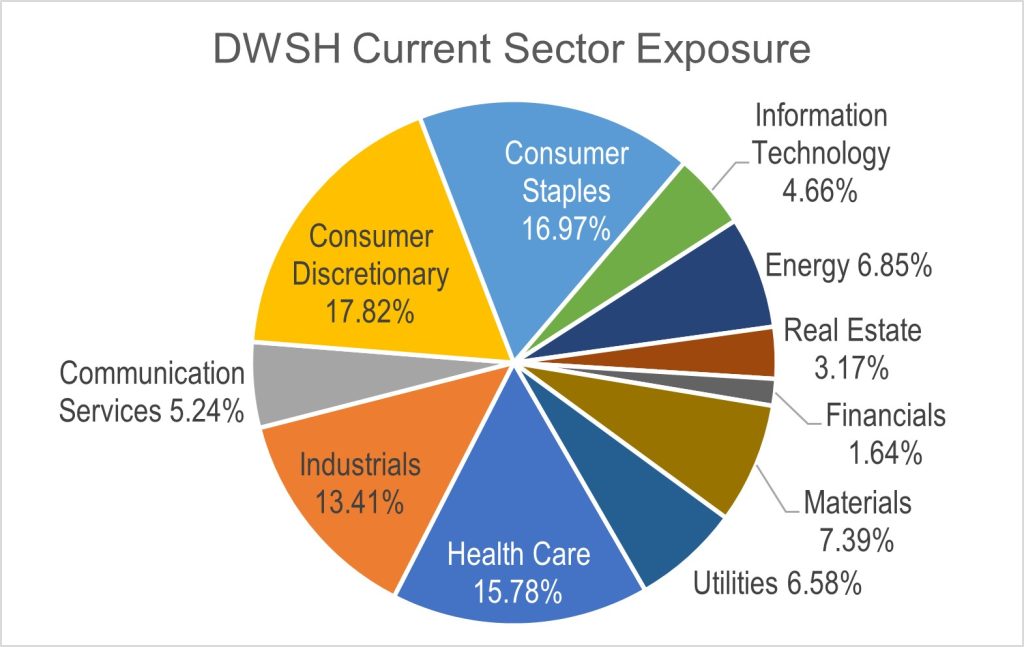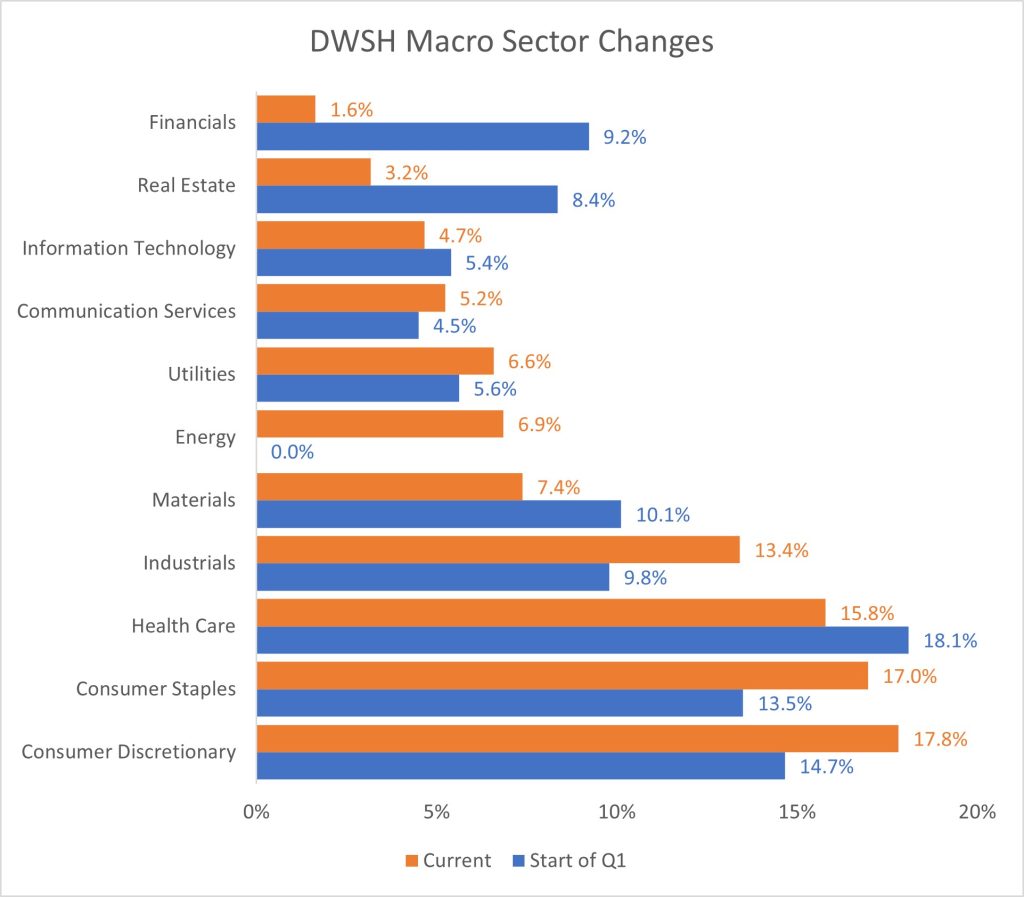DWSH: 1st Quarter 2024 Portfolio Review
Strategy
The AdvisorShares Dorsey Wright Short ETF (Ticker: DWSH) is built on the relative strength testing that Dorsey Wright has been doing for over almost two decades. Rather than investing in those companies that are exhibiting the strongest relative strength however, we identify the bottom tier or laggards and short them. Shorting using relative strength is by no means a new idea, when reading academic literature on momentum from the past 40 years, the idea of buying the past winners and shorting the losers is often found to be a sensible allocation.
Our vision for utilizing the strategy is twofold. First is can be used as a hedge against downside US equity volatility, helping to reduce the volatility of the portfolio by pairing DWSH with a traditional long portfolio. The second is using the strategy as an alpha bet during period of market distress. During period of high dispersion among securities, there are typically well-defined winners and losers. Rather than buying a broad short of the whole market, we systematically invest in companies that are identified to be weak and have a greater chance in our opinion of dropping more than the other companies drop in the universe.
Performance
Momentum performed very well in Q1 2024 and that included the short side as well. Even though the S&P 500 rallied +10.56%, DWSH only fell -0.57% (market). We’ve seen a similar trend over the last 12 months as the S&P 500 has rallied 29.88% while DWSH has only fallen -14.60% (market). This quarter was helped by stocks like Weight Watchers which has fallen almost 50% since we added it to the portfolio a little over a month ago. We’ve also been short New York Community Bank (NYCB) which has fallen almost 40% over the last two months.
Holdings
Currently the portfolio is comprised of 100 companies spread across the major macro sectors. This number will fluctuate over time as positions grow to a larger allocation of the portfolio and as securities are replaced in our sell process. As securities are removed from the portfolio, the new purchases will be allocated at roughly equal weight, depending on the cash level. Over the quarter we saw 38% of the portfolio turnover.
Top 10 Holdings
| Ticker | Security Description | Portfolio Weight % |
| EL | ESTEE LAUDER COMPANIES-CL A | -1.29% |
| UAL | UNITED AIRLINES HOLDINGS INC | -1.30% |
| HLF | HERBALIFE LTD | -1.32% |
| HCSG | HEALTHCARE SERVICES GROUP | -1.33% |
| RIG | TRANSOCEAN LTD | -1.33% |
| AR | ANTERO RESOURCES CORP | -1.34% |
| VAC | MARRIOTT VACATIONS WORLD | -1.35% |
| MPW | MEDICAL PROPERTIES TRUST INC | -1.46% |
| HBI | HANESBRANDS INC | -1.62% |
| MTZ | MASTEC INC | -1.63% |
As of 3.31.2024.

As of 3.31.2024.
Portfolio Changes
The portfolio saw many changes this quarter with the biggest sector shift coming from Financials where we reduced exposure by -7.58%. On the other side, we saw increased exposure to Energy (+6.85%) and Industrials (+3.61%).

As of 3.31.2024.
John G. Lewis
Nasdaq Dorsey Wright
AdvisorShares Dorsey Wright Short ETF (DWSH) Portfolio Manager
Past Manager Commentary
- Alpha: One of the most commonly quoted indicators of investment performance, alpha, is defined as the excess return on an investment relative to the return on a benchmark index.
- Long: Having a “long” position in a security means that you own the security. Investors maintain “long” security positions in the expectation that the stock will rise in value in the future.
- Short: A “short,” or a short position, is created when a trader sells a security first with the intention of repurchasing it or covering it later at a lower price. A trader may decide to short a security when they believe that the price of that security is likely to decrease in the near future.
- The S&P 500 Index is a broad-based, unmanaged measurement of changes in stock market conditions based on the average of 500 widely held common stocks.
Before investing you should carefully consider the Fund’s investment objectives, risks, charges and expenses. This and other information is in the prospectus, a copy of which may be obtained by visiting www.advisorshares.com. Please read the prospectus carefully before you invest. Foreside Fund Services, LLC, distributor.
The Fund is subject to a number of risks that may affect the value of its shares, including the possible loss of principal. Short sales are transactions in which the Fund sells a security it does not own. To complete the transaction, the Fund must borrow the security to make delivery to the buyer. The Fund is then obligated to replace the security borrowed by purchasing the security at the market price at the time of replacement. If the underlying security goes down in price between the time the Fund sells the security and buys it back, the Fund will realize a gain on the transaction. Conversely, if the underlying security goes up in price during the period, the Fund will realize a loss on the transaction. Any such loss is increased by the amount of premium or interest the Fund must pay to the lender of the security. Likewise, any gain will be decreased by the amount of premium or interest the Fund must pay to the lender of the security. Because a short position loses value as the security’s price increases, the loss on a short sale is theoretically unlimited. Short sales involve leverage because the Fund borrows securities and then sells them, effectively leveraging its assets. The use of leverage may magnify gains or losses for the Fund. As with any fund, there is no guarantee that the Fund will achieve its investment objective.
Shares are bought and sold at market price (closing price) not NAV and are not individually redeemed from the Fund. Market price returns are based on the midpoint of the bid/ask spread at 4:00 pm Eastern Time (when NAV is normally determined), and do not represent the return you would receive if you traded at other times.
Holdings and allocations are subject to risks and to change.
The views in this commentary are those of the portfolio manager and may not reflect his views on the date this material is distributed or anytime thereafter. These views are intended to assist shareholders in understanding their investments and do not constitute investment advice.

